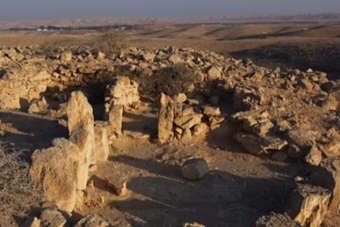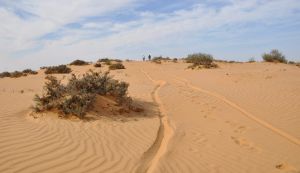How people not only survived but burgeoned in desert highlands 4,500 years ago had been an enigma.

Evidence of ancient habitation at Mashabei Sadeh, 4,500 years ago, but what did they live on? Photo by Zach Dunseth
The Negev has been inhabited for thousands of years, sometimes quite thickly. Archaeological evidence has shown there were sudden population explosions in the desert highlands. Some lasted longer than others, but all receded back into the desert sand — but just how did any of them survive in the deep desert?
Archaeologists had assumed they farmed. Now new evidence suggests they did not, instead having a much more advanced economy than had been suspected. And what is this evidence? Fossil feces — and its absence.
The conclusion is the fruit of an ongoing collaboration by archaeologists with scientists in studying the 5,000-year-old site of Mashabei Sade.
The question was whether the residents of this large site, in the middle of nowhere in the Negev, subsisted on animal husbandry or not. So they undertook a new excavation of the site, searching specifically for coprolites — ancient animal dung.
Population explosions in the desert
The ruins of Mashabei Sadeh date to around 2500-1950 BCE, a period known as the Intermediate Bronze Age. The sprawling site, some 12 dunams wide, lies deep in the hills of the Negev Desert, about two miles south of the modern town of the same name.
The Mars-like landscape contains around 200 scattered ancient structures.
 Mashabei Sadeh: How large populations survived in the Negev is quite the question — and, it seems, it wasn’t by farming. Photo by Haim Taragan
Mashabei Sadeh: How large populations survived in the Negev is quite the question — and, it seems, it wasn’t by farming. Photo by Haim Taragan
Mashabei Sadeh is a relatively unique site in the history of the Negev Highlands, in terms of size and preservation. What makes it even more unique is that it is located several kilometers from any natural water source. It is however near wadis — dry riverbeds that flow during the rainy season, which means the locals could have theoretically grown crops.
The site is being excavated as part of the Negev Highlands Research project, directed by Israel Finkelstein of Tel Aviv University and Ruth Shahack-Gross of the Weizmann Institute. Mashabei Sadeh itself is being excavated by [Weizmann Institute] doctoral student Zach Dunseth. Their aim: to elucidate subsistence practices — how people survived the cruel conditions in the Negev. Also, they hope to gain new light on ancient life-habits of the inhabitants of the Negev Highlands during the settlement peaks throughout history, which remain a mystery.
The first known population explosion was in the Early Bronze Age, about 5,000 years ago. It happened again multiple times during the Intermediate Bronze Age, briefly within the Iron Age (what some call the biblical period), and then again more recently, in the Byzantine and Early Islamic periods.
During the Intermediate Bronze Age, as the north of the Land of Israel was undergoing a period of de-urbanization, the Negev was experiencing a wave of settlement. No one fully understands why this occurred. In their search for clues, archaeologists turned to a study very familiar to them but less so to the public: coprolites. What they found astonished them: the population explosions were not sustained by agriculture, it seems.
Gold in them thar dirt hills
“Basically, I study ancient, animal dung. So, if I’m lucky, I come across intact animal dung, known as coprolites. Finding them is like striking gold, since animal dung is an excellent recorder of ancient animal diet and if analyzed correctly, material in animal dung can inform us about the presence of herds, seasonal migrations and even whether the ancient populations practiced agriculture,” Dunseth says.
Information about diet comes from microscopic particles in the fossil dung. The most important of these particles for archaeologists are phytoliths: microscopic particles of silica that form in plant cells. When the plant is eaten, the particles are preserved in dung.
Most plants produce phytoliths, and scientists can differentiate between those from natural woody shrubs, like those native to the Negev Highlands, and cultivated domestic cereals.
Through ethnographic studies, researchers know that traditional sedentary pastoralists, like the Bedouin, fodder their herds with the inedible chaff and cereal byproducts from their harvests. If such cultivated material is found in ancient animal dung at an archaeological site — it attests that the inhabitants of the ancient settlement practiced both animal husbandry and agriculture.
A hand to mouth existence?
The team studied two sites in Mashaabe Sadeh: the central, larger site, and for comparison, a smaller encampment nearby, featuring a large courtyard surrounded by smaller units.
Both sites date to the Intermediate Bronze Age, and neither exhibits any evidence of administration or city planning.
Absolutely no evidence was found at the large site of any form of the traditional subsistence practices in this region: "No animal pens, no faunal remains, no stone tools like sickle blades, and most of all, no dung," says Dunseth. "The absence of dung is surprising, as it is fairly common at Negev sites from other periods. This leads us to believe that this large settlement was probably sustained by some other form of economy.”
The smaller temporary site did have evidence of degraded fossilized dung — indicating that at the smaller site, a form of agriculture was practiced.
The results beg questions.
If they didn’t keep animals or farm, how did large communities survive in the middle of nowhere, in the Negev? Why would they even want to live there? Dunseth suggests they may have engaged in the copper trade — ancient mines have been discovered at Wadi Feinan or Timna in the Arava Valley which were active around the same time as the inhabitation of this site. It is also possible that the inhabitants profited from the Red Sea trade.
“There must be an explanation hidden somewhere in the ground, but at this point what we have are only hints of something greater, of Mashabei Sadeh being a part of a far larger economy,” Dunseth speculates.
The findings debunk the archaeological assumption that most of the Intermediate Bronze Age population engaged in subsistence farming.
But possibly the people back then had a much more advanced system in place than modern man gives the ancients credit for. In fact, the evidence indicates the existence of a much larger regional and possibly international economy, of which the Negev community at Mashabei Sadeh was just one small cog.
